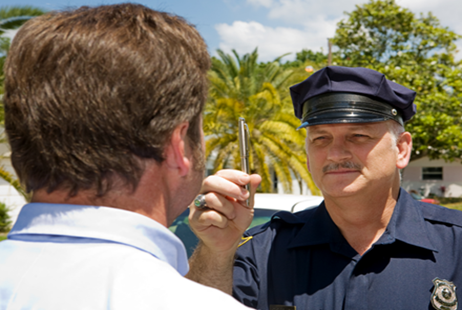Field Sobriety Test Primer – The Full Instructions and Full Scoring Criteria of the Three Standardized DWI Evaluations
By: William C. Head, Atlanta DUI Attorney
During our client interviews, many people arrested for DUI tell us about their DUI tests. Many of these clients think that the HGN evaluation took 3 to 4 minutes. Rarely does an officer take longer than 2 minutes on this initial evaluation, and that includes giving the VGN (vertical gaze nystagmus) evaluation, as the last part of the HGN test.
Because no client, and no DUI lawyer hired to represent a client arrested for driving under the influence, can recall the exact wording of NHTSA standardized instructions used by each police officer at the roadway, without the benefit of video tape review, it is helpful to look at how the three sobriety test exercises are SUPPOSED to be instructed, to comply with training. From our experience, the instructions, demonstrations, and scoring by various police officers is done differently by each, and really is NOT standardized.
The NHTSA Standardized Three-Test Battery
Police officers are taught to give three NHTSA standardized field sobriety tests, and to give the evaluations in a certain sequence. First comes the Horizontal Gaze Nystagmus test of the person’s eyes, followed by the Walk and Turn evaluation, and then the One Leg Stand evaluation. From the time I took my first course in field tests in July of 1994, this has been the order of an officer requesting the evaluations.
The Horizontal Gaze Nystagmus (HGN) Eye Test
Police officers tend to be influenced by what is observed during the HGN evaluation. If he or she sees 4 or 6 clues, many officers are trying to “see” more problems with the next two evaluations, to bolster their arrest decision. So, even the most miniscule flaw is scored, and jurors clearly see the proof that these evaluations were designed to fail. This “bias” is likely caused by three primary influencers, which are caused by the NHTSA practitioner training.
First, our SFST instructors told us that the evaluations were progressive, meaning that if insufficient clues were observed on HGN, then there was no need to bother with the next two evaluations. Since the types of DUI tests are of different character (psycho-physical versus involuntary eye movements), this guideline was not only curious, but made no sense at all.
Second, the HGN test was touted by NHTSA instructors as being “the most reliable” of the field sobriety test battery. Officers, therefore, rely too heavily on this test as being “near perfect” when it is far from being a true test in terms of reliability. We believe the HGN is too sensitive, and shows 4 or more clues on over half of all subjects with BAC levels under a 0.08 grams percent. Due to faulty administration, instructions and scoring, this has not been verified by actual practice. In fact, the error rate for the ten officers rating the OLS (one leg stand) evaluation in the 1977 study was lower than the error rate on the HGN.
Third, although most basic training given to new police trainees includes instruction about and being trained on the walk and turn and the one leg stand, most academies warn new officers to NOT attempt to use the HGN evaluation until they have gone through the NHTSA standardized field sobriety test course practitioner course, or 20 to 24 hours in length. So, the newbie police officers are conditioned to think that HGN is the Holy Grail of sobriety testing.
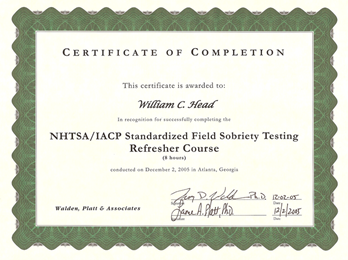
This “bias” factor was reported in a NHTSA-sanctioned study, but their findings were from a different perspective than a seasoned DUI attorney, after attending over a dozen SFST practitioner courses, plus taking four instructor courses, as well as three DRE overview courses, two “refresher” courses, followed by watching over 10,000 police videos. (Anderson, Schweitz, and Snyder, Field Evaluation of a Behavioral Test Battery for DWI, DOT-HS-806-475, September 1983).
The HGN eye test is the one NHTSA field sobriety test that is considered sufficient proof of the test subject likely being “over the legal limit” when 4 or more clues are observed. The problem with the horizontal gaze nystagmus eye test is that environmental factors, such as wind, rain, lighting conditions, temperature, and background distractions can cause erroneous scoring. Plus, a high percentage of officers trying to administer this eye-tracking test do SOME part of it incorrectly. Due to this, more false arrests are made due to unreliable performance and administration of the DUI eye test than the other two standardized field sobriety tests combined.
The three greatest errors in giving the nystagmus test are: (1) failure to medically qualify the subject, (2) holding the stimulus too high, at 4” or more above eye level, and (3) not adhering to the proper speed and constant maintenance of a level plane for each “pass” of the stimulus, to include the proper stopping points, the precise timing for holding the stimulus stationary, and the common sense requirement to not move the stimulus outside the test subject’s field of lateral vision.
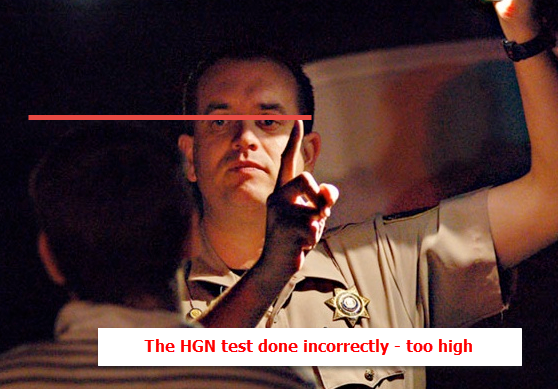
Because the walk and turn and the one leg stand evaluations have limitations for certain health issues and body size limitations, and cannot be done by people with orthopedic deficiencies, balance issues (from disease or trauma), and due to advanced age, officers often cannot get any clues (cues) for these two SFST evaluations. One British study concluded that more than half the people over age 40 cannot perform the walk and turn and the one leg stand sobriety tests STONE COLD SOBER. Evaluation of a roadside impairment test device using ethanol; Dixon, Clark & Tiplady, Accident Analysis and Prevention (2009), p. 412-418.
Nystagmus is involuntary jerking of the eye. Research shows that there are more than 40 types of eye nystagmus. The HGN test is designed to measure the type of nystagmus that occurs when the eyes gaze to the side. HGN will occur in any person’s eyes when gazing extremely sideways, but NHTSA maintains that when a person is intoxicated there are these signs that become apparent in his eye movements: (1) the nystagmus occurs much sooner, that is, the less the person’s eyes have to move before the jerking occurs; (2) if the person’s eyes move as far to the side as possible, the greater the alcohol impairment, the more distinct the nystagmus will be at the extreme gaze position; and (3) an intoxicated person cannot follow a slowly moving object smoothly with his eyes. The HGN test is intended to identify and measure these three signs.
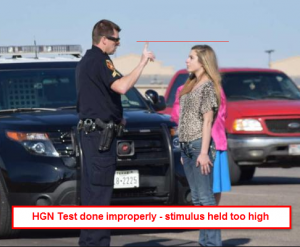
Here is what is TAUGHT by NHTSA. The author in NO WAY believes that the three NHTSA field sobriety tests are RELIABLE or VALID, bases upon over 22 years of experience and study of these police “arrest” tests. But, here is what is taught:
Each of the three tests in the SFST battery is briefly described below, along with the administrative steps that must be followed, and the scoring clues applicable to each test. The actual descriptions in the NHTSA manual are considerably more extensive. In addition, the standardized procedures for each test generally require that the officer provide clear and specific directions and demonstrate what the subject must do. Failure to do so invalidates the test effectiveness. The tests must be administered outside the vehicle in a well-lighted area suitable for walking and standing, and safe from oncoming traffic.
The Horizontal Gaze Nystagmus (HGN) Test
The key element of measuring HGN is correctly estimating when the eye has reached a deviation angle of 45 degrees. NHTSA maintains that when someone’s BAC is above .10%, the jerking will begin before his eye has moved 45 degrees to the side. Officers trained with the NHTSA training procedure are provided a template for practicing how to estimate the 45 degree angle, but they are not required to use a template when they administer the test in the field.
Test Conditions
The test requires the use of an object for the subject to follow. The NHTSA training manual says that this can be a fingertip, penlight, or pen. It must be held slightly above eye level and 12-15 inches away from the person’s nose. The police officer must inquire and make note of whether or not the suspect if he is wearing contact lenses, but the lenses do not have to be removed for the test. However, a suspect wearing glasses must be made to remove them.
Standardized Test Procedure
The officer must administer the test following these procedures.
- The officer instructs the suspect that he is going to check his eyes, that he must keep his head still and follow the object only with his eyes, and that he must focus on the object until told to stop.
- The officer must hold the stimulus 12-15 inches from the suspect’s nose and slightly above eye level. He must move the stimulus smoothly across the suspect’s entire field of vision and check to see if the eyes are tracking together or one lags behind the other. (If the eyes do not track together, it could be a sign of a medical disorder, injury, or blindness.)
- The officer next must check to see that both pupils are the same size (if not, it could be a sign of a head injury).
- The officer starts with the left eye and smoothly moves the stimulus to the right at a speed such that it takes about two seconds to being the person’s eye as far to the side as it can go. He then moves the stimulus similarly to the left to check the person’s right eye.
- Using this process, the officer must check for all three clues in both eyes, always starting with the left. He must check at least twice for each clue in each eye.
- The officer must check for the clues in this sequence: lack of smooth pursuit, sustained and distinct nystagmus at maximum deviation, and onset of nystagmus prior to 45 degrees.
- When checking for nystagmus at maximum deviation, the officer must move the stimulus to the side until no white is showing at the side of the suspect’s eye, and then hold the position for four seconds.
- When checking for nystagmus onset angle, the officer must move the stimulus at a speed that would take about four seconds to reach the edge of the suspect’s shoulder. Watch the eye for jerking and, when it occurs, stop and verify that it continues while the stimulus is stopped.
- The four-second speed of the stimulus movement is important. If the object moves too fast, the officer could go past the point of onset, or miss it altogether.
- If the suspect’s eyes start to jerk before 45 degrees, the officer must check to see that some white is still showing on the side of the eye closest to the ear. If no white shows, this means either that the officer has taken the eye too far to the side (more than 45 degrees) or the person has unusual eyes that do not deviate very far.
Standardized Clues
There are three scoring clues that are measured for each eye, giving a maximum of six scoring points should all three clues be present in both eyes. If four or more clues are observed, the NHTSA manual states the person should be classified with a BAC above .10%. These are the scoring clues.
- Lack of smooth pursuit (the eyes bounce or jerk as they follow the object)
- Distinct and sustained nystagmus at maximum deviation when the stimulus is held stationary for four seconds at maximum deviation. While some people exhibit jerking at maximum deviation even when sober, in an intoxicated person the jerking should be “very pronounced, and easily observable.”
- Onset of nystagmus before the eye has moved out to 45 degrees.
These are the only three clues NHTSA recognizes as valid indicators of HGN. NHTSA specifically does not support the position that the exact onset angle can be used to estimate a person’s specific BAC, and considers this to be a misuse of the HNG test.
An officer is then supposed to check for VGN, vertical gaze nystagmus, by starting the stimulus at eye level, and moving it up smoothly until the subject’s eyes can go no higher, and then back down for the eyes to follow the stimulus, until the eyes can track no lower, and then repeat this movement to verify what was observed.
The Walk-and-Turn (WAT) Test
The test has two distinct parts. The first part (instruction phase) requires the subject to balance heel-to-toe while the officer gives the instructions and demonstrates the test. The second part of the test requires the subject to take nine heel-to-toe steps on a straight line, pivot around, and take nine heel-to-toe steps back.
Test Conditions
The required test conditions are level ground, a hard, dry, non-slippery surface, and conditions under which the suspect is in no danger should he fall. The student training manual states that the test criteria are not necessarily valid for people age 65 or older, or people with leg injuries or inner ear disorders. (Prior editions of the NHTSA DWI manual stated this limitation as applicable to people more than 60 years of age, or more than 50 pounds overweight, or people with physical impairments that affect their balancing ability. The reason for the change does not appear in the manual.)
Suspects with heels more than two inches high, or other unusual footwear, should be offered the chance to remove their shoes for both this evaluation and the one leg stand test.
The WAT test requires a line that the suspect can see and follow. If a natural line is not present, the officer must draw one in the dirt or on a sidewalk with chalk. Walking parallel to a curb is not acceptable. The suspect must be able to see the line to perform the test. His eyes must be open and have adequate light available. The manual states that if the officer can see the suspect clearly, the lighting is adequate. Otherwise, the officer must use a flashlight to illuminate the line.
A person who cannot see out of one eye may have difficulty performing the test because of poor depth perception. The suspect must watch his feet because this makes the test more difficult for an intoxicated person. The officer must observe the suspect performing the test from three to four feet away and remain motionless. Standing too close to the test subject or moving while the test is going on makes it more difficult even for a sober person to perform the test.
Standardized Test Procedures
The WAT test must be administered as follows.
- Instruct the subject to place the left foot on the line and the right foot heel-to-toe in front of it (demonstrate).
- Verify that the suspect understands that the stance must be maintained while the instructions are given.
- If the suspect breaks from the stance during the instructions, stop the instructions until the stance is resumed.
- Tell the suspect that he will be required to take nine heel-to-toe steps down the line, turn around, and take nine steps back down the line, but not to begin until instructed.
- Demonstrate two or three heel-to-toe steps and the turn.
- Instruct the suspect to keep both arms at his sides, watch his feet, count the steps out loud, and not to stop walking until the test is completed.
- Ask if the suspect understands the directions and, if not, repeat whatever he does not understand but not the entire set of directions.
- Tell the suspect to begin and count his first step from the heel-to-toe position as one.
- If the suspect staggers, steps off the line or stops while walking, allow him to resume from the point of interruption. Do not have him repeat the test from the beginning. (The manual states that the test loses its sensitivity if it is repeated.)
Standardized Scoring Clues
The WAT test procedure has eight specific scoring clues the officer must track. The clues must be scored if the suspect:
- Loses balance during the instructions (his feet break from the heel-to-toe stance)
- Starts walking before the instructions are completed and he is instructed to start.
- Stops while walking to steady himself (but does not score this clue if he is only walking slowly).
- Leaves more than one-half inch between his feet during any heel-to-toe step.
- Steps off the line (if this occurs three times the test is terminated and the officer must score it as if all eight clues were shown). side to maintain balance.
- Turns improperly either by removing the front foot from the line while turning, removing both feet from the line, or clearly does not follow the directions as demonstrated.
- Takes the wrong number of steps in either direction.
If the suspect cannot do the test, the officer must score it as if all eight clues were present.
If the suspect clearly exhibits two or more of the eight clues or cannot complete the test, the officer must classify his BAC as above .10%. Officers are instructed to note in their report how many times each clue appears, but count it only once for scoring purposes.
The One-Leg-Stand (OLS) Test
The OLS test requires a suspect to stand with his arms at his side and raise and hold one leg at least six inches off the ground for 30 seconds. He must count the seconds out loud according to specific instructions. The 30-second time period is important to the test since NHTSA research indicates that it makes the test sensitive to people in the .10% to .15% BAC range who might otherwise pass the test if they only had to maintain the position for less time. NHTSA research has shown that someone with a BAC above .10% can maintain balance for up to 25 seconds but seldom for 30 seconds.
Test Conditions
The conditions required for the OLS test are like those for the WAT test. There must be light adequate to provide a visual frame of reference. The officer must observe motionless from three to four feet away for the same reasons as for the WAT test. The test criteria are not necessarily valid for people age 65 or older, people 50 pounds or more overweight, or people with leg injuries or inner ear disorders.

Standardized Test Procedures
The NHTSA-specified test procedures for the OLS test are as follows.
- Instruct subject to stand with feet together and arms down at sides (demonstrate).
- Tell the subject not to start until told.
- Ask if the subject understands instructions.
- Explain to the subject that when told to start he must raise one leg, either his left or right, approximately six inches off the ground with the toe pointed out (demonstrate stance).
- Tell the subject he must keep both legs straight with his arms at his side and, while holding the position count out loud for 30 seconds saying “one thousand and one, one thousand and two, etc.” until told to stop (Demonstrate the counting method).
- Remind the subject he must keep both arms at his sides at all times throughout the test and keep watching his raised foot.
- Ask if he understands, and get a confirmation of his understanding.
- Tell him to begin the test.
- Observe the subject from three feet away and remain “as motionless as possible.” If he puts his foot down, instruct him to pick it up again and resume counting from the point it touched the ground. If he counts very slowly, end the test after 30 seconds. If he counts quickly, make him continue until told to stop.
Standardized Scoring Clues
The test is scored according to four scoring clues. If the suspect is:
- Swaying side-to-side or back-and-forth while maintaining the one-leg stance
- Moving arms six inches or more from the sides to maintain balance
- Hopping in order to maintain the one-leg stance
- Putting his foot down one or more times during the 30 seconds.
If the suspect cannot do the test or puts his foot down three or more times, the officer must record the results as if all four clues were scored.
Other Notes
NHTSA has developed and promoted the use of the Standardized Field Sobriety Test battery consisting of the Walk-and-Turn (WAT), One-Leg-Stand (OLS), and Horizontal Gaze Nystagmus (HGN) tests. NHTSA recognizes only these DUI tests in its training protocols, and does not endorse the use of any other types of field sobriety tests and similarly validated evaluations. It also makes it clear that the validity of the test battery depends on strict adherence to the designated administration and scoring principles it has developed. If they are followed exactly, NHTSA asserts that the HGN test is 77% reliable in identifying those with BACs of .10% or more, the WAT test is 68% accurate, and the OLS test is 65% accurate.
The HGN test combined with the WAT test is claimed to have 80% reliability. If the procedures are not followed exactly, NHTSA states that “the decision making guidelines will not be accurate.”
Failure to pass any of the three tests is determined by counting specific scoring clues NHTSA specifies for each test. The presence of a predetermined number of clues indicates a failure to perform the test. For HGN, four or more clues are the “number,” and for either the Walk and Turn or One Leg Stand, the “number” is two or more clues.
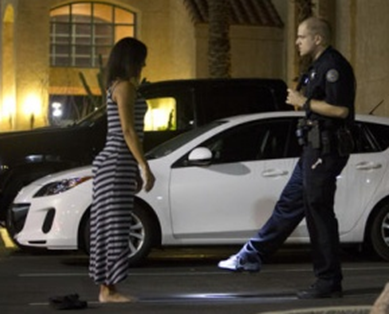
This final phase of establishing a basis of probable cause for arrest involves administration of the structured field sobriety tests. In some jurisdictions that allow for them, this can also include the administration of a preliminary DUI breath test. Speak to a DrunkDrivingDefense.com attorney anytime day, night, and weekends at 1-888-839-4384.
Further Reading
For more information on field sobriety tests, take a look at one of our articles detailing specific aspects of these DUI tests below:
- Field Sobriety Tests in the United States
- Field Sobriety Tests are Voluntary
- Should I Take Field Sobriety Tests?
- What Happens If I Refuse the DUI Tests?
- If I Don’t Take Field Sobriety Tests, Will I Lose My License?
- Are Field Sobriety Tests Reliable?
- Are Police Properly Trained On Field Sobriety Tests?
- Can Field Sobriety Test Errors Help Me?


